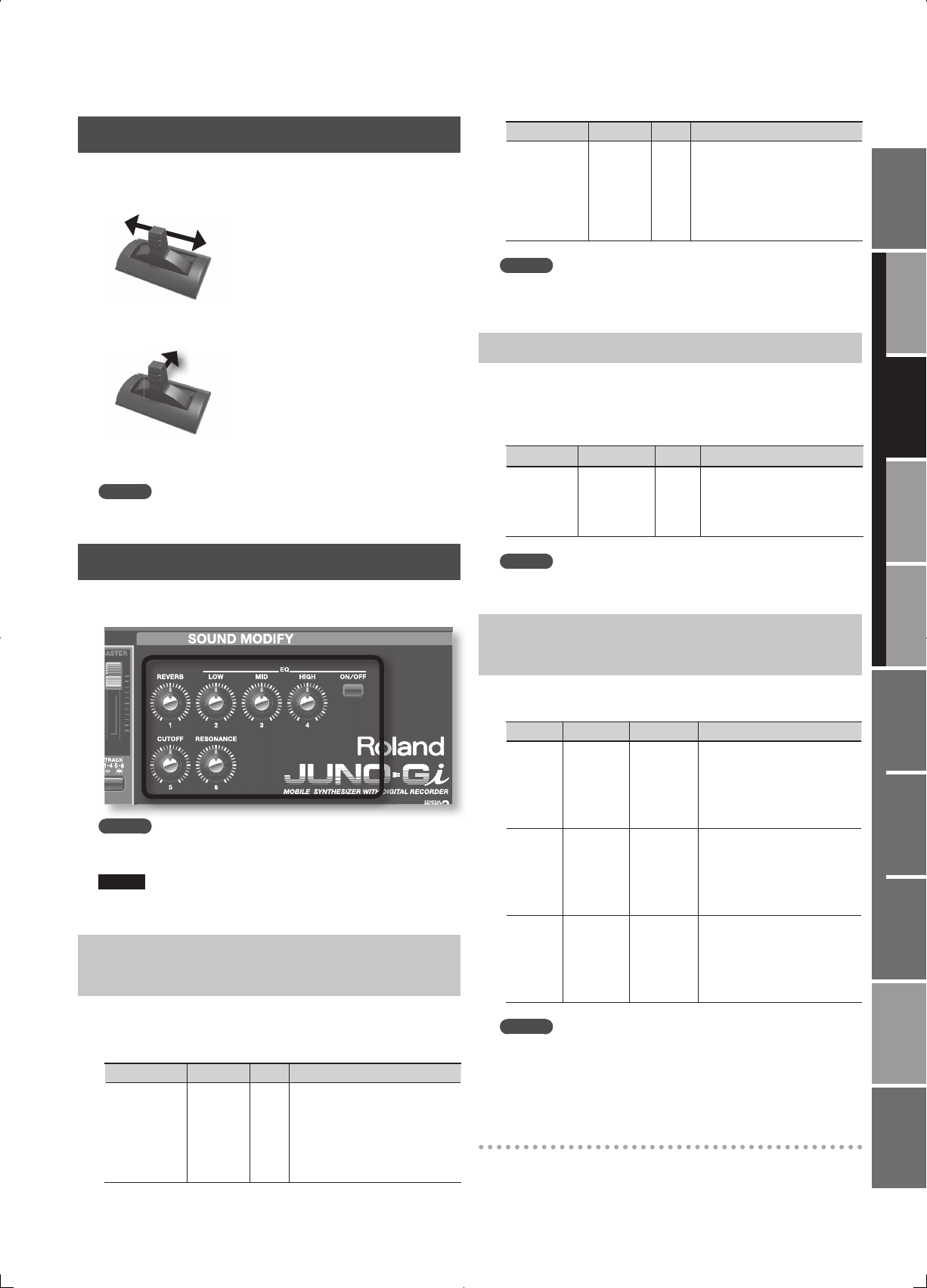
29
Overview
Appendix
USB Memory
Song Player
Digital Recorder
Synthesizer
Selecting Sounds Perform. Functions Editing/Eects Other Settings
Rec/Play/Edit Eects Rhythm Pattern
Pitch Bend/ Modulation Lever
While holding down a key, moving the lever to the left will lower the
pitch, and moving it to the right will raise the pitch. This is called “pitch
bend.”
Pushing the lever away from yourself will apply vibrato. This is called
“modulation.”
Pushing the lever away from yourself while moving it to the left or
right will apply both e ects simultaneously.
MEMO
The pitch bend range can be speci ed separately for each layer.
Refer to “Bend” (p. 36).
[SOUND MODIFY] Knob
You can use the SOUND MODIFY knobs to modify the sound in real
time.
MEMO
By holding down the [SHIFT] button and moving a knob, you can
check the current value without modifying the setting.
NOTE
Depending on the settings of the live set, turning a knob might not
a ect the sound in some cases.
Modifying the Tonal Character
([CUTOFF]/[RESONANCE] Knobs)
You can use these knobs to adjust the lter that cuts or boosts speci c
frequency regions of the sound.
These a ect the following parameters of the currently selected live set.
Knob Parameter Value Explanation
[CUTOFF]
knob
Cuto
O set
-64–
+63
Adjusts the frequency (cuto
frequency) at which the lter begins
to be applied.
Turning the knob toward the right
will brighten the sound, and turning
it toward the left will darken the
sound.
Knob Parameter Value Explanation
[RESONANCE]
knob
Resonance
O set
-64–
+63
Boosts the sound in the vicinity
of the cuto frequency, adding a
distinctive character to the sound.
Turning the knob toward the right
will strengthen this character, and
turning the knob toward the left
will weaken it.
MEMO
The Cuto and Resonance e ects apply only to the Synthesizer.
They do not a ect the sound of the Digital Recorder or the USB
Memory Song Player.
Adding Reverberation ([REVERB] Knob)
You can add reverb (reverberation) to the sounds that you play from
the synthesizer.
By adding reverb, you can recreate the pleasant acoustics that are
typical of a performance in a concert hall or similar space.
Knob Parameter Value Explanation
[REVERB]
knob
Reverb Level 0–127
Adjusts the amount of reverb.
Turning the knob toward the
right will deepen the reverb, and
turning it toward the left will
decrease the reverb.
MEMO
The Reverb e ects apply only to the Synthesizer. They do not a ect
the sound of the Digital Recorder or the USB Memory Song Player.
Adjusting the Level of the Low, Middle and High
Frequency Ranges (EQ [LOW]/[MID]/[HIGH] Knobs)
Use the knobs to adjust the equalizer (EQ) that applies to the overall
sound.
Knob Parameter Value Explanation
[LOW]
knob
Low Gain
-15–0–+15
dB
Adjusts the low range sound.
Turning the knob toward the
right will boost the low range
sound, while turning it toward the
left will attenuate the low range
sound.
[MID]
knob
Mid Gain
-15–0–+15
dB
Adjusts the middle range sound.
Turning the knob toward the
right will boost the middle range
sound, while turning it toward
the left will attenuate the middle
range sound.
[HIGH]
knob
High Gain
-15–0–+15
dB
Adjusts the high range sound.
Turning the knob toward the
right will boost the high range
sound, while turning it toward the
left will attenuate the high range
sound.
MEMO
• The equalizer applies not only to the Synthesizer but also to the
sound of the Digital Recorder and the USB Memory Song Player.
• You can use the System setting “[3] (MST EQ)” (p. 81) to make more
detailed equalizer settings.
Turning the equalizer on/o ( EQ [ON/OFF] button)
You can use the EQ [ON/OFF] button to turn the equalizer on/o .


















